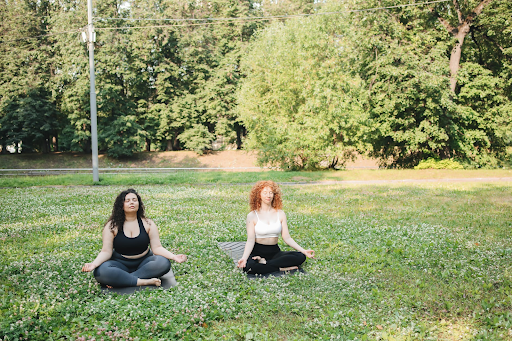In today’s fast-paced and stressful world, maintaining physical and mental health has become more critical than ever. Amidst the hustle and bustle of daily life, finding ways to de-stress and rejuvenate both the body and mind is essential. Regularly practicing yoga can significantly contribute to our overall well-being, promoting physical fitness, mental clarity, and emotional stability. In this blog, we will explore the various ways in which yoga can be good for staying physically and mentally healthy, highlighting the importance of attending yoga classes whether at a yoga teacher training in Goa or anywhere else in the world. Attain these benefits by incorporating yoga into our daily lives.
The Physical Benefits of Yoga
- Enhances Flexibility: Yoga poses, known as asanas, involve gentle stretching and movement, which gradually improve flexibility. Regular practice can help loosen tight muscles and increase the range of motion in joints, reducing the risk of injuries in daily activities.
- Strengthens Muscles: Many yoga poses require supporting one’s body weight, effectively engaging and strengthening various muscle groups. Consistent practice leads to increased muscle tone and endurance.
- Improves Posture: Yoga emphasizes alignment and body awareness, which helps in developing a correct posture. Proper alignment not only enhances physical appearance but also prevents strain on the spine and reduces back pain.
- Boosts Balance and Coordination: The focus on balance during yoga poses enhances proprioception – the ability to sense the position of one’s body in space. This improvement in balance and coordination can benefit various physical activities and reduce the risk of falls, especially in older adults.
- Increases Stamina: Yoga incorporates controlled breathing and continuous movement, which can improve cardiovascular health and increase overall stamina and energy levels.
The Mental Benefits of Yoga
Stress Reduction: One of the most significant advantages of yoga is its ability to reduce stress and anxiety. The deep breathing techniques, mindfulness, and meditation incorporated in yoga practices activate the body’s relaxation response, calming the nervous system and promoting a sense of tranquility.
Enhances Mental Clarity: The focus required during yoga sessions can lead to improved concentration and mental clarity. It helps individuals become more present, reducing mental chatter and allowing for better decision-making and problem-solving.
Promotes Emotional Well-Being: Yoga encourages self-awareness and self-acceptance, fostering a positive outlook on life and improved emotional regulation. It can be particularly helpful in managing conditions like depression and mood disorders.
Encourages Mindfulness: Mindfulness, the practice of being fully present in the moment, is a fundamental aspect of yoga. Regularly practicing mindfulness helps cultivate a sense of gratitude and contentment, leading to overall life satisfaction.
Reduces Symptoms of Anxiety and Depression: Research has shown that yoga can be effective in reducing symptoms of anxiety and depression, making it a valuable complementary therapy for those struggling with mental health issues.
The Importance of Attending Yoga Classes
- Guided Practice: Yoga classes are led by experienced instructors who can provide personalized guidance and correct alignment, ensuring that participants perform poses safely and effectively.
- Structured Routine: Attending regular yoga classes establishes a consistent routine, making it easier to incorporate yoga into one’s daily life. Consistency is key to experiencing the full benefits of yoga.
- Community Support: Yoga classes offer the opportunity to connect with like-minded individuals, creating a supportive community that fosters motivation and accountability.
- Access to Various Yoga Styles: There are numerous styles of yoga, each with its unique focus and benefits. Attending classes allows individuals to explore different styles and find the one that resonates best with their needs and preferences.
- Stress-Free Environment: Yoga studios provide a serene and focused environment, free from distractions, where participants can fully immerse themselves in the practice and experience deep relaxation.
5 Top Yoga Poses to Get Started With
If you’re new to yoga and looking to establish a regular practice, starting with foundational poses is essential to build strength, flexibility, and confidence. These beginner-friendly yoga poses are accessible to all levels and will lay a solid foundation for your yoga journey. Remember to warm up before attempting these poses and focus on proper alignment and breathing. Here are five top yoga poses to get started with regular practice:
- Mountain Pose (Tadasana):
The Mountain Pose is the foundation for many standing yoga poses and helps improve posture, balance, and body awareness.
How to do it?
– Stand with your feet hip-width apart, arms at your sides, and palms facing forward.
– Distribute your weight evenly through your feet, engaging your leg muscles.
– Lengthen your spine, lift the crown of your head towards the ceiling, and relax your shoulders.
– Breathe deeply, grounding yourself through your feet, and hold for 30 seconds to 1 minute.
- Downward Facing Dog (Adho Mukha Svanasana):
This popular yoga pose stretches and strengthens the entire body, including the shoulders, hamstrings, and calves. It also helps relieve tension in the back and neck.
How to do it?
– Come on your hands and knees
– Curl your toes under, lift your hips towards the ceiling, and straighten your legs as much as possible.
– Hold the pose for 5 to 10 breaths, focusing on the stretch in your hamstrings and the openness in your shoulders.
- Warrior II (Virabhadrasana II):
Warrior II is an empowering standing pose that strengthens the legs, opens the hips, and improves concentration.
How to do it?
– Begin in a standing position with your feet about 3 to 4 feet apart. Turn your right foot 90 degrees outward and your left foot inwards.
– Bend your right knee, aligning it with your ankle while keeping your left leg straight.
– Extend your arms to the sides, parallel to the ground, with your gaze over your right fingertips.
– Keep your shoulders relaxed and your torso facing the side, engaging your core.
– Hold the pose for 5 to 8 breaths, then switch sides.
- Child’s Pose (Balasana):
The Child’s Pose is a gentle resting pose that stretches the back and helps relieve stress and fatigue.
How to do it?
– Sit on the floor and kneel.
– Sit back on your heels and fold your torso forward, resting it on your thighs.
– Bring your arms in front of you.
– Relax your forehead on the mat and take slow, deep breaths.
– Hold the pose for 1 to 2 minutes, feeling the stretch in your lower back and hips.
- Tree Pose (Vrksasana):
Tree Pose improves balance, concentration, and stability while also stretching the thighs and groins.
How to do it?
– Start in Mountain Pose. Shift your weight onto your left foot and lift your right foot off the ground.
– Place the sole of your right foot against your left inner thigh, above or below the knee (avoid placing it on the knee joint).
– Find your balance and bring your hands to your heart center in a prayer position.
– Lengthen your spine, and if you feel stable, raise your arms overhead, palms facing each other.
– Hold the pose for 30 seconds to 1 minute, then switch sides.
Focus on Breathwork to Enhance Mental Health
Our breathing patterns are closely linked to our emotions and stress responses. When we are stressed, we breathe rapidly. Conversely, when we are calm and relaxed, our breath is slow, deep, and steady. By recognizing this connection, we can actively use breathwork to influence our mental and emotional states positively.
Effective Breathwork Techniques for Mental Health
- Diaphragmatic Breathing (Deep Belly Breathing): This technique involves breathing deeply into the abdomen rather than shallowly into the chest. It activates the relaxation response and can be done in a comfortable seated or lying position.
How to do it?
Place one hand on your chest and the other on your abdomen.
Inhale deeply through your nose, expanding your abdomen while keeping your chest relatively still.
Exhale slowly through your mouth, allowing your abdomen to contract.
Continue this rhythmic breathing for several minutes.
- Box Breathing (Square Breathing): Box breathing is a simple technique that helps regulate the breath and calm the mind.
How to do it?
Inhale deeply through your nose to a count of four.
Hold your breath for a count of four.
Exhale slowly through your mouth for a count of four.
Pause and hold your breath for another count of four before starting the cycle again.
Repeat this pattern for several rounds.
- Alternate Nostril Breathing (Nadi Shodhana): This pranayama technique balances the left and right hemispheres of the brain, promoting a sense of harmony and clarity.
How to do it?
- Sit comfortably with your spine straight.
- Using your right thumb, close off your right nostril.
- Inhale deeply and slowly through your left nostril.
- Close off your left nostril with your right ring finger, releasing your right nostril.
- Exhale slowly and completely through your right nostril.
- Inhale deeply and slowly through your right nostril.
- Close off your right nostril again and release your left nostril.
- Exhale slowly and completely through your left nostril.
- This completes one round. Repeat for several cycles.
Programs like yoga teacher training in Goa, Rishikesh, Kerala, and various other destinations in Asia lay emphasis on aiding students to achieve holistic well-being by way of Yoga. It is beneficial to commence the journey of well-being at one of these destinations before taking up independent practices. By embracing the holistic benefits of yoga, individuals can achieve a more balanced and fulfilling lifestyle. So, roll out your mat, breathe deeply, and embark on a journey of wellness through yoga. Namaste!



